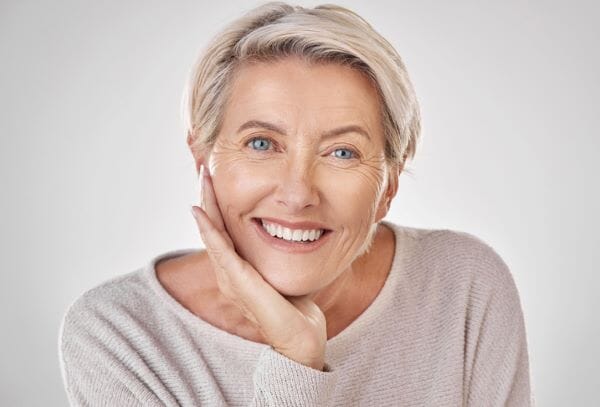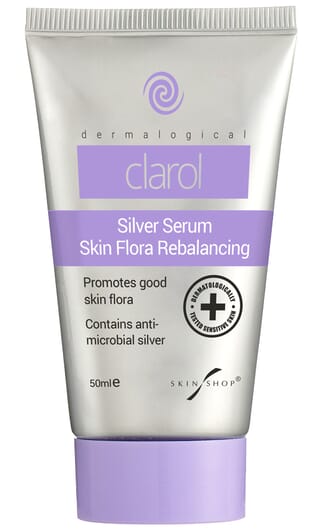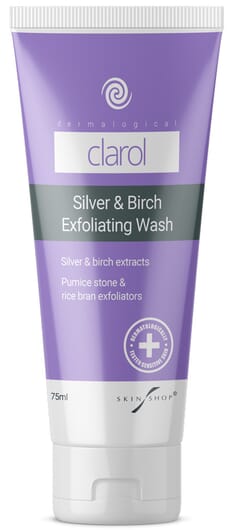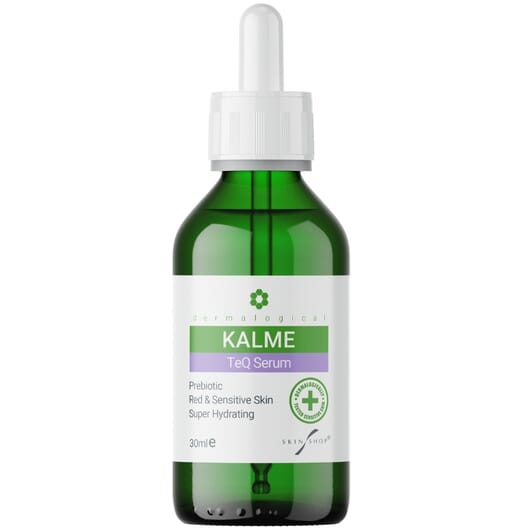Studies show that adult acne in women is on the increase, with perimenopausal acne in women over the age of 45 seeing one of the sharpest rises over the last five years.
The latest research suggests that almost 30% of women will experience perimenopausal acne in the run up to the menopause, even if they have never had acne before.
Contrary to the assumption that like teen acne, perimenopause and acne is directly caused by the hormonal flux leading up to the menopause, in fact it’s the changes in the skin as a result of hormonal flux that leaves the skin more vulnerable or susceptible to perimenopausal acne.
Hormones are not actually the cause of perimenopausal acne which is why cystic acne isn’t as common in perimenopausal acne as it is in acne in young adults.
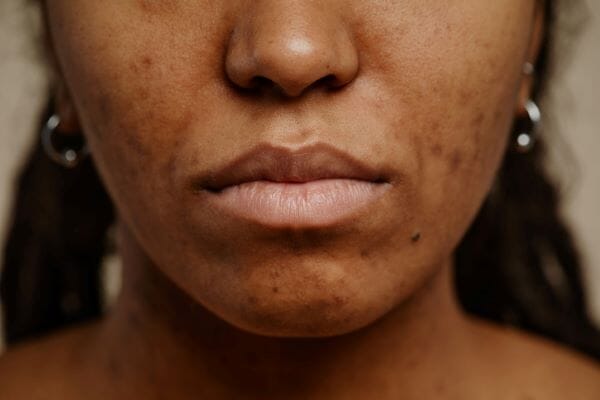
The main cause of changes in the skin in perimenopausal women is a shift in balance between oestrogen and androgens. In the perimenopausal phase androgen levels (either of adrenal or ovarian origin) tend to be higher, which is what is primarily responsible for the changes in the skin of perimenopausal women.
Perimenopausal acne is also often accompanied by underlying redness and inflammation, called acne rosacea, which is most common in women aged 45 plus and is caused by underlying over-reactivity and dilation of capillaries beneath the skins surface.
Perimenopausal acne on chin is also common, which is due to the elevated androgen levels during this period.
Consultant dermatologist Dr Eve Melegh identifies four changes in perimenopausal skin that can leave it more susceptible to perimenopausal acne.
Weakened skin barrier function
In perimenopausal skin, the skin barrier function becomes weaker due to the drop in oestrogen, which is what gives skin its elasticity.
A weakened skin barrier function leads to dryness which causes chaffing and microdamage as well as more gaping (open) skin pores. Both of these elements allows external bacteria to enter more easiy raising the chances of infection and acne.
In this scenario, acne is not caused by too much sebum as with teen acne, but in fact not enough moisture in the skin.
How to treat it
Perimenopausal acne prone skin needs to be moisturised. Washes and products for acne that are aimed at drying up sebum are the worst thing for perimenopausal acne.
Instead, overnight serums with intensely hydrating ingredients and preferably containing skin prebiotics to help repair and rebuild weakened skin barrier function are a more effective option.
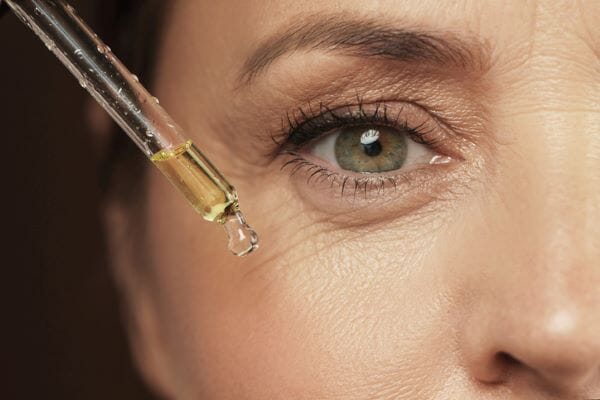
Kalme TeQ Serum is a super hydrating and skin repairing prebiotic serum containing extracts of blue agave and pure plant-based squalane to replenish skin barrier function as well as an anti-redness ingredient from caper extract which helps recuce underlying inflammation and redness.
Decrease in good skin bacteria
This is still a relatively new area of research, but studies suggest that acne during perimenopause could be in part due to changes in the skin’s microbiome (the bacteria living on the skin’s surface) due to declining oestrogen levels.
Menopausal change has been observed to influence the number of good bacteria living on the skin’s surface, with reductions in the diversity of these beneficial bacteria.
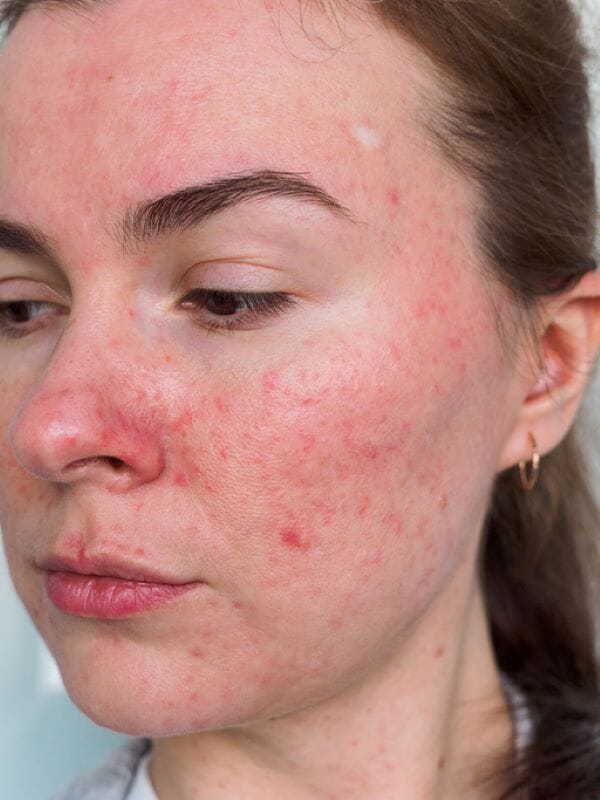
A decline or change in levels of good skin bacteria means that levels and diversity of bad skin bacteria can start to increase. It’s the bad skin bacteria that leads to skin pore infection and acne as well as exacerbating acne rosacea.
How to treat it
Effective perimenopausal acne treatment to address this issue needs to target increasing and aiding the growth of good skin bacteria.
Clarol Silver Serum is a skin serum containing a targeted micronized silver ingredient that directly feeds good skin bacteria while repelling bad skin bacteria. This can quickly and effectively address this tendency towards bacterial imbalance in perimenopausal skin to help reduce perimenopausal acne and acne related to acne rosacea
Skin Sensitivity
With less good skin bacteria plus weakened skin barrier function, perimenopausal skin becomes more sensitive and prone to reactions to chemicals and perfumes in normal skincare, suncreams and cosmetics.
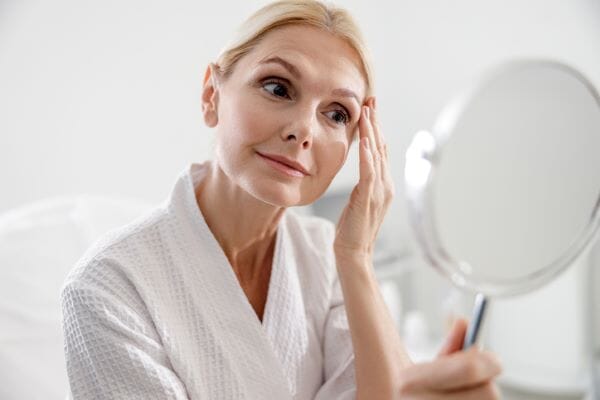
With skin reactions, the skin becomes inflamed and red, which stretches open the skin pore and allows external bacteria to enter the skin pore more easily leading to infection and acne.
Howe to treat it
A key to controlling perimenopausal acne is to keep skin inflammation to a minimum and that means controlling sensitivity.
The first step is to reduce the use of skin care products that contain large amounts of chemicals ingredients, preservatives and perfumes. Products need to contain more naturally sourced ingredients, be suitable for sensitive skin and contain no perfumes.
Kalme Undercoat is a base coat product designed to be worn under other skincare products, cosmetics and suncreams that contains a specific de-sensitising ingredient to reduce the skin’s reactivity.
Increased Facial Hair
Due to a period of higher androgen levels in perimenopausal skin, hair growth on the face (hirsutism) can increase during the perimenopause.
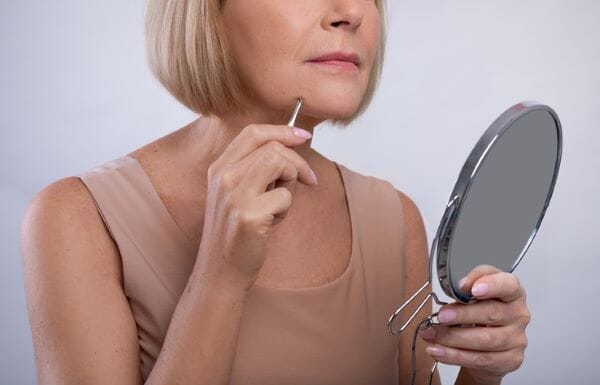
An increase in facial hair growth can cause the hair follicle to become more easily blocked and inflamed, leading to folliculitis acne, which is when external bacteria gets into the hair follicle.
How to treat it
Exfoliation is the most effective way to reduce acne related to infected hair follicles while also increasing skin cell turnover.
However, exfoliation in perimenopausal skin must be gentle with a fine and natural exfoliant as the skin is more fragile.
Manual exfoliation every 1-2 days plus an acid exfoliation once every 3-4 days is a good routine for skin prone to perimenopausal acne and should keep hair follicles uncongested.
Clarol Silver & Birch Exfoliating Wash contains an extract of birch bark, that contains natural equivalents of both salicylic acid and methyl salicylate, two synthetic chemicals commonly used in anti-acne products. Birch Bark also contains betulin to help reduce inflammation. Pumice stone and rice bran provide gentle manual exfoliation in this natural exfoliating wash.
Products containing alpha-hydroxy acids (AHA’s and beta-hydroxy acids (BHA’s) help exfoliate multiple layers of the skin and are good for use 1-2 times a week for a more profound acid exfoliation and to help brighten complexion and accelerate skin cell turnover.



